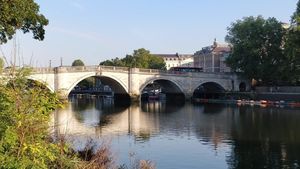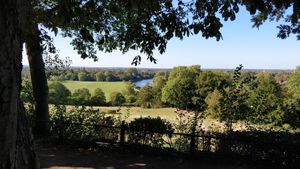
Richmond Bridge, which spans the River Thames, is a stunning and historically significant crossing that connects the towns of Richmond and Twickenham. Originally completed in 1777, it is the oldest surviving bridge over the Thames in London and exudes a sense of timeless charm with its elegant Georgian design.
The bridge was constructed to replace a ferry service which was proving to be both unreliable and unsafe at the time. Its design, by James Paine and Kenton Couse, garnered praise for both its functionality and its graceful architectural lines. Interestingly, this bridge has undergone several modifications since its inception, including widening works completed in the 1930s to accommodate increased traffic.
One quirky aspect of Richmond Bridge is its unique blend of stone and brickwork, which was partly a result of cost-saving measures during its construction. This mix of materials gives the bridge its distinctive appearance, setting it apart from many others in the city.
Richmond Bridge is not only a vital transport link but also a beloved walking path for locals and visitors alike. Walking across the bridge provides panoramic views of the picturesque riverside, with charming houseboats and leafy surroundings that seem worlds away from the bustling metropolis of London.
The bridge has inspired countless artists and writers over the centuries, including J.M.W. Turner, whose evocative river scenes were heavily influenced by this mesmerizing landscape. The bridge's setting continues to be a favorite subject for artists and photographers to this day.
Richmond Bridge also played a historical role during World War II, when it was used as a strategic crossing. Despite the intense period, it emerged relatively unscathed, allowing it to continue serving both its practical and cultural roles in the community.

Making the Most of Your Visit:
Take an early morning walk across Richmond Bridge for a serene experience. The soft light and quiet atmosphere are perfect for soaking in the views without the usual hustle and bustle of the day.
If you're a photography enthusiast, don't forget your camera! The bridge offers angles capturing both the natural beauty of the river and the charming architectural details of nearby buildings. Early evening is particularly magical when the lights begin to reflect off the water.
Head downstream from the bridge to the riverside path on the Richmond side. This scenic walk offers lovely views back towards the bridge, combined with some idyllic spots to relax and watch the world go by.
For a touch of local flavor, wander over to the food market on a Saturday or Sunday. It's just a short stroll from the bridge in Heron Square, and you can enjoy a fresh pastry or artisan coffee while you admire the river views.
Watch out for rowers and canoeists when standing on the bridge. The perspective from above gives you a unique view of the lively river activity below, which is particularly charming during the rowing season.

Visiting Times & Costs:
Richmond Bridge is open to the public at all times, throughout the year. It serves as a public thoroughfare with no entry fees or charges for crossing.
Accessibility is generally good, with paths leading to the bridge, although the gradient may be a consideration for those with mobility issues. It is advisable to approach with caution if using mobility aids or if wheelchair access is required, as there might be uneven surfaces.

Address & Map:

Nearby:























